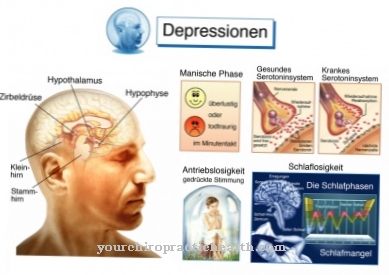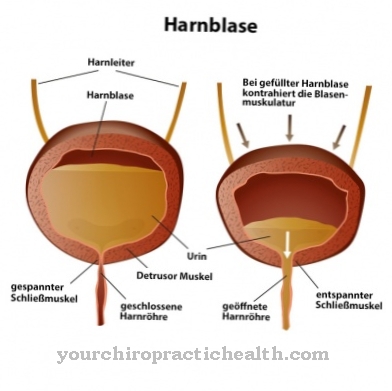Under a classic Nerve block the impairment or complete blockage of peripheral nerves is understood in their function as a stimulus conductor for motor, sensory and vegetative impulses. The permanent or facultative impairments of the nerves can be triggered by mechanical pressure or tension stimuli or by chemical stimuli and, depending on the severity of the lesion, lead to constant pain and limited function of the affected muscles up to complete paralysis and powerlessness.
What is a nerve block?

© inegvin - stock.adobe.com
Peripheral nerves are usually multifunctional and consist of specialized motor, sensory and vegetative nerve fibers (fascia), which are isolated from each other by envelope tissue and are surrounded by the epineurium as a whole as a nerve cord. The motor fascia pass voluntary contraction or relaxation impulses to “their” muscles, which then contract or relax.
While the sensitive fascia “transport” sensory and haptic stimuli - including pain sensations - the vegetative fibers serve to conduct impulses for control circuits that are not subject to the will. Since the peripheral nerves sometimes have to overcome anatomical constrictions or run in special bone channels, they can be damaged by muscle tension as a result of overloading or unilateral and recurring incorrect loads caused by pressure or tension.
This causes corresponding motor, sensory and vegetative disorders, which can also be expressed through intense pain. A total blockage of the nerve, e.g. B. as a result of a transection, the total paralysis of "his" muscle results because the muscle no longer receives motor contraction impulses.
causes
In addition to accidents that can lead to direct lesions of peripheral nerves, the main causes of nerve blocks are mostly due to recurring poor posture and stress. It is then a repetitive strain injury (SRI), which can manifest itself through a variety of symptoms. A trigger factor can already be extremely monotonous, prolonged writing on the screen if the workplace is ergonomically set up in a suboptimal manner and at the same time there is constant stress due to multitasking, which triggers a permanent tone in various muscles and can lead to compression damage to the peripheral nerves.
Another typical cause of a blockage of peripheral nerves can be a herniated disc, in which the intervertebral disc tissue exerts pressure on the nerve root at the outlet opening from the spinal canal. Depending on the impairment of the affected nerve, pain and symptoms can be radiated into the supply areas of the affected nerve.
In addition to mechanical bruises and lesions, nerve blocks can also be caused systemically by chemical substances (e.g. fungus, snake or jellyfish poisoning), some of which can be irreversible and irreparable or even life-threatening.
Symptoms, ailments & signs
The symptoms of a nerve block depend on its cause. If the disease can be traced back to a bad posture that has persisted for years, complaints often occur in the back, shoulder and neck area. These can resemble tension or stiffness, or they can express themselves as severe pain. These symptoms can also occur in the cervical and thoracic spine if the disease was triggered by incorrect posture.
An equally common symptom is prolonged headache. Accidents are also one of the known causes of a nerve block. If these wear and tear lead to a cervical vertebra syndrome, complaints occur in the shoulder and neck area. In the worse case, feelings of paralysis or numbness can arise, which last for a long time or even only become noticeable after a certain time.
Often times, whiplash injuries experienced in the past are the cause of these symptoms. If vessels or nerves are pinched, those affected often notice a tingling sensation in the arms and hands, as if these limbs had "fallen asleep". The underlying disease is called Scaleneus Syndrome and refers to the nerves that lie between the shoulder blade, collarbone and the cervical spine. Another symptom of a nerve block is breathing difficulties. These can be the result of any of the named causes.
Diagnosis & course
The most important symptoms of a nerve block are permanent pain with simultaneous tingling in the extremity supplied by the affected nerve and noticeable loss of strength in the limb. If a nerve block is suspected, an examination of motor skills, haptics and pain sensitivity is carried out.
Further clinical clarification options are the measurement of nerve conduction velocity and electromyography (EMG). The EMG can provide information on whether a detected weakness of the muscle is due to a disease of the muscle itself or to the reduced functionality of the nerve.
In severe cases, imaging techniques such as myelography or CT can be used. If nerve blocks are left untreated and the causes for the blockage do not recede or a possible poisoning cannot be broken down by the body, irreversible paralysis, insensitivity to pain and muscle wasting will occur because the muscle is no longer required.
Complications
The symptoms and complications of a nerve block depend very much on the severity of the disease. As a rule, those affected suffer from severe pain and continue to suffer from paralysis and disorders of sensitivity. This paralysis can spread to other regions of the body and lead to restrictions in everyday life for the person concerned. Furthermore, the patients also appear exhausted and powerless and can often no longer move their muscles.
In some cases, the patients are dependent on the help of other people in their everyday life and suffer from significant mobility restrictions. The patient's sensitivity to pain also increases significantly due to the nerve block, and muscle wasting occurs if the nerve block continues over a longer period of time. The quality of life of the person affected is significantly reduced and restricted by the disease.
In this case, treatment can take place with the help of various therapies and thus alleviate the symptoms.However, it cannot be universally predicted whether this will be successful. In some cases, surgical interventions are also possible to release the nerve block. The patient's life expectancy may also be reduced due to the nerve block.
When should you go to the doctor?
If tension, pain, or numbness occurs, it may be due to a nerve block. A doctor must be consulted if the symptoms do not go away on their own within a few days to weeks or if they occur suddenly. If there is severe pain or movement restrictions, an immediate doctor's visit is necessary. People who have had a herniated disc or a serious accident with bruises and lesions are particularly prone to developing a nerve block.
People with chronic malpositions and stresses also belong to the risk groups and should consult a doctor in the event of the symptoms mentioned. The doctor can quickly identify a nerve block and refer the patient to a suitable specialist. The condition is treated by an orthopedic surgeon or internist, depending on the type and severity of the symptoms. The actual therapy usually also involves physiotherapists or sports medicine specialists. In order to ensure a quick recovery, close consultation with a doctor must be maintained during treatment. In severe cases, treatment in a rehabilitation center is necessary.
Treatment & Therapy
In the case of clearly diagnosed nerve blocks, the first goal of therapy is to remove the cause of the nerve damage so that the nerve can then regenerate. In many cases, conservative physiotherapy and other accompanying applications can help.
Special deblocking techniques can also be used, which consist of an attempt to passively or actively remobilize the affected muscle areas. The specially trained therapist uses certain techniques that are intended to release the muscle blockage. If the nerve has been severed and the distal and proximal ends are too far apart, neurosurgical intervention at a specialist clinic may be indicated.
During the operation, the two nerve endings are first identified and then connected to one another using a special technique so that they can regenerate again postoperatively. If the connection between the two nerve endings is not possible without tension, a piece of the body's own other nerve can be used as a bridging link.
Alternatively, relocating the nerve can be an option if this avoids tensile stress that may be feared later. Such an operation must be followed by a rest period of at least 2 weeks as a regeneration phase.
You can find your medication here
➔ Medicines for painOutlook & forecast
A one-time nerve block subsides within a few minutes. Any signs of paralysis, numbness or pain should quickly subside. The prospect of a speedy recovery is positive, provided that the patient determines the cause of the nerve block and consults a doctor.
With recurring nerve blocks, the prognosis is less good. Nerve blocks are a major stress factor for the body. The psychological stress is also great, as the timing and intensity of the blockages cannot be foreseen. In the long term, this can lead to anxiety disorders and other psychological complaints. Work in physically or mentally demanding jobs is usually no longer possible, as the nerve blocks inevitably lead to failures.
An alternative is drug treatment, which, however, is also associated with complications. The exact prognosis depends on whether the nerve blocks can be stopped with conservative treatment. If this is not possible because, for example, it is based on a neurodegenerative disease, the prognosis is based on the course of the causative disease. Life expectancy and quality of life also depend on the other symptoms and complaints of the underlying disease.
prevention
Prevention of nerve blocks mainly consists in avoiding recurring incorrect loads and constant stress without recovery phases. As active preventive measures, regular relaxation exercises, light and regular sporting activity and gymnastics, which should primarily include stretching the muscles, are recommended.
Aftercare
In most cases, the affected person has very few and usually limited measures of direct follow-up care available. Therefore, the early detection and treatment of this disease is paramount in order to prevent further complications and complaints from occurring. Self-healing cannot occur, although the further course depends very much on the type and severity of this disease.
Therefore, no general prediction can be made about the further course. In many cases, those affected are dependent on the measures of physiotherapy or physiotherapy for the nerve block. Many of the exercises from these therapies can also be performed in your own home to accelerate healing.
Many of those affected depend on the help and support of their own families in their everyday lives. Loving conversations have a positive effect on the further course of this disease and can also prevent depression and other psychological upsets. The nerve block usually does not reduce the patient's life expectancy.
You can do that yourself
People who suffer from chronic nerve blocks are exposed to physical and emotional stress. Medical therapy can effectively treat the health problems associated with a blockage of the nerves. This works best if the patient supports the treatment with some self-help measures.
First, however, the cause of the nerve block must be determined. A complaint diary provides information about possible triggers. Then the sick person can take specific measures to alleviate the symptoms. Depending on the cause, this could include exercise, massages or conversations with other people affected. Psychotherapeutic treatment of the causes is particularly important in the case of mentally caused nerve blocks.
After a procedure, the patient initially needs a lot of rest and relaxation. After that, physical strain should initially be avoided, whereby the doctor's instructions also play a role. Mild nerve blocks can often be relieved with moderate exercise. In addition, the doctor must be consulted so that the necessary measures can be taken quickly if the state of health deteriorates. The self-help measures mentioned should be used with the consent of the doctor.


.jpg)


.jpg)
.jpg)




















